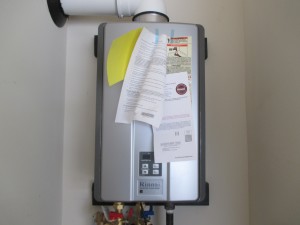Hey!
Lately I’ve been seeing a lot of tankless water heaters and I have to say, I love ‘em! The three big advantages of tankless water heaters are space and energy savings and the theory of unlimited hot water. For those who haven’t see one, they are small boxes that hang on the wall. Here’s a picture of one I looked at this week. 
As far as energy efficiency, they are great because they don’t have tanks, thus eliminating any standby energy loss. Did you know that heating water accounts for about thirty percent of an entire homes energy budget. I had no idea it was that high, but if that’s true, I can see how tankless water heaters can save home owners a lot of money. Most manufacturers say that tankless water heaters save home owners about 50% over their tanked counterparts. They really are great and I’m excited every time I see one. While they do save folks a lot of money, it’s important to run the numbers yourself before going out and buying one, because they’re a lot more expensive than traditional units. Some people say the savings alone aren’t worth it.
Most tankless water heaters are gas powered since gas has a quicker recovery time than electric. They work by sensing the movement of water through the system. When hot water is needed, the unit uses internal burners and a heat exchanger to heat the water that passes through it. Since there is not a storage tank and the unit heats water with a powerful heat exchanger, you theoretically never have to worry about running out of hot water, as long as you have a properly sized unit. Improperly sized units are the most common problems I see during my inspections. The easiest way to determine if a unit is properly sized is to run several hot water faucets and a bathtub at the same time for several minutes. This will give you a good idea as to whether the unit is sized properly. Also, since tankless water heaters don’t have tanks like traditional water heaters, they only require a pressure relief valve (PRV) instead of a Temperature, Pressure relief valve (TPRV). A TPRV releases water from the unit when the water becomes too hot or the pressure becomes too high. Since tankless water heaters don’t have tanks, there is no need to for the unit to measure the temperature of the water stored in the tank. Instead, they only monitor pressure. For this reason, PRV are required on tankless units.
One major downside to tankless water heaters, other than cost, are in repairs. Its recommended that the units be serviced every year. Not having your unit serviced can decrease it lifespan. If it’s not serviced properly, Calcium can build up and decrease water flow and lower the efficiency of the unit.
So that’s about it for tankless water heaters. This was kind of a hodgepodge article, but it’s Sunday night and I’m tired and hungry. I’m going to go get me a cinnamon scone and make some tea with hot water from a non-tankless water heater.
Be Happy and Be Kind,
T.J. Thorne





